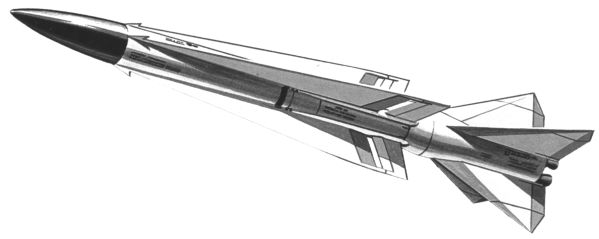Bendix AAM-N-10 Eagle
In 1957, the U.S. Navy began to plan a new concept for airborne fleet defense. A large subsonic interceptor with a powerful radar was to be equipped with very long range high speed anti-aircraft missiles to shoot down approaching bombers at distances of more than 185 km (100 nm). In December 1958, Bendix was selected as prime contractor for the AAM-N-10 Eagle missile, with major subcontracts let to Grumman (airframe) and Aerojet (main propulsion). About a year later the contract for the launch platform went to the Douglas F6D Missileer design, which was to carry six AAM-N-10 missiles.
 |
| Drawing: Douglas |
| AAM-N-10 |
The most important feature of the F6D was its Westinghouse AN/APQ-81 pulse-doppler radar, the first track-while-scan radar developed for a fighter aircraft. The AN/APQ-81 could detect targets at a distance of 220 km (120 nm), but the F6D would normally be supported by W2F-1 (later E-2) Hawkeye AEW (Airborne Early Warning) aircraft which could detect threats at ranges of more than 370 km (200 nm). After launch, the AAM-N-10 would be boosted to Mach 3.5 by a large solid-propellant rocket booster with folding fins, and after a glide period, the long-burning solid-fueled sustainer motor would propel the missile toward its target at a speed of Mach 4.5. The AN/APQ-81, which could simultaneously track up to eight targets from 150 km (80 nm) away, would send guidance commands to the individual missiles to keep the latter on course to their respective targets. With the mid-course command guidance, the AAM-N-10 could fly an energy-efficient "lofted" trajectory, and maximum aerodynamic range was more than 300 km (160 nm). When the Eagle would be close enough to the target, the missile's own radar (developed from the AN/DPN-53 of the IM-99/CIM-10 Bomarc) would take over and guide the weapon to the interception point. The effective interception range of the F6D/AAM-N-10 combination was about 200 km (110 nm), but the AAM-N-10's radar could also home directly on jamming sources, in which case effective range could be as big as 300 km (160 nm). Normally, the Eagle would have used a large high-explosive warhead, but a low-yield W-42 nuclear fission warhead was also considered for some time.
The F6D/AAM-N-10 development program would have been very expensive, and a re-evaluation of the "slow interceptor" concept eventually led to the cancellation of the whole program in December 1960, before any XAAM-N-10 prototypes could be tested. However, the idea of a long-range fleet-defense interceptor survived, and was eventually realized much later with the F-14 Tomcat and the AAM-N-11/AIM-54 Phoenix missile.
Specifications
Note: Data given by several sources show slight variations. Figures given below may therefore be inaccurate!
Data for AAM-N-10:
| Length (w/o booster) | 3.53 m (11 ft 7 in); booster: 1.38 m (4 ft 6.5 in) |
| Finspan | 0.86 m (2 ft 10 in); booster: 1.27 m (4 ft 2.1 in) |
| Diameter | 36 cm (14 in); booster: 41 cm (16 in) |
| Weight (w/o booster) | 295 kg (650 lb); booster: 287 kg (634 lb) |
| Speed | Mach 4.5 |
| Ceiling | 30000 m (100000 ft) |
| Range | 200 km (110 nm) |
| Propulsion | Sustainer: Aerojet solid-fueled rocket; booster: AiResearch solid-fueled rocket |
| Warhead | High-explosive |
Main Sources
[1] Norman Friedman: "US Naval Weapons", Conway Maritime Press, 1983
[2] Bill Gunston: "The Illustrated Encyclopedia of Rockets and Missiles", Salamander Books Ltd, 1979
Back to Directory of U.S. Military Rockets and Missiles, Appendix 1
Last Updated: 6 January 2003